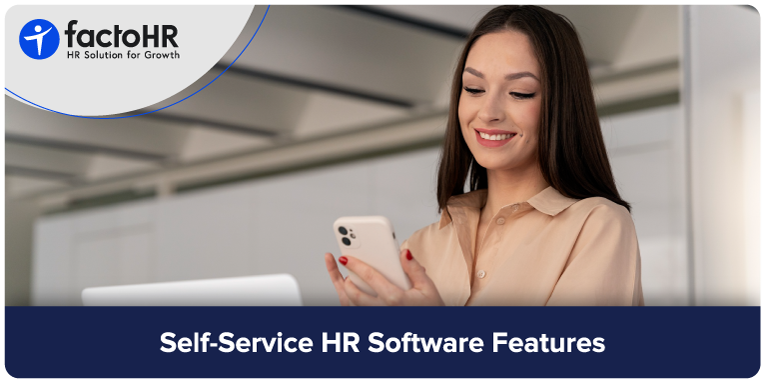What is Self-Service HR Software: 10 Must-Have Features

Table of Contents
HR professionals repeatedly manage various HR-related tasks, from guiding new employees to dealing with employee relations. As a result, routine tasks like sanctioning leave applications and answering simple queries can pile up and become overwhelming. This issue is not industry-specific, and almost all business sectors struggle with these challenges, making it necessary to have self-service HR software.
ESS portals help reduce the administrative burden on the HR team, allowing them to focus more on other important strategic decisions. This platform can help an organization increase its overall productivity and maintain a more efficient work environment. When employees want to contact HR or managers, 88% of employees prefer online portals over HR emails. These statistics show the transparency and convenience of using Self-Service HR Software.

What is Self-Service HR Software?
Self-Service HR Software is an empowering digital tool that enables employees to effortlessly manage essential HR tasks. With just a few clicks, they can update personal information, check leave balances, and view payroll details, all while enjoying greater independence and efficiency in their work experience.
ESS, also known as HR self-service, can track and update an employee’s personal information without the need for actual paperwork. Employees can view their salary information or tax forms, which gives them greater control over their personal information. Traditional HR methods like recruitment and employee management increased the workload on HR professionals, which led to inefficiency in resolving simple queries.
Employees can access their personal and HR-related information through a convenient mobile app, which helps reduce the administrative burden on HR teams. It also allows HR professionals to simplify workflow approval and improve the collective employee experience.
Why is Self-Service HR Software Important for the HR Team?
The Self-Service HR Software helps manage tasks more efficiently and allows employees to handle easy queries themselves. A study observed that 67% of employees choose ESS portals over directly reaching out to their managers or supervisors.
The portal ensures that all routine requests are managed quickly and reduces the load on HR personnel. An employee self-service portal is needed in modern organizations for many reasons, which include improved employee autonomy and operational efficiency. Data accuracy can be maintained when employees are given the authority to update their information. This ease of use reduces the administrative burden on the HR department, letting them focus on other tasks, like talent management and employee engagement.

10 Must-Have Features in Self-Service HR Software
Self-service HR software has changed how organizations manage their HR functions. They are now more structured, and employees have the freedom to access their information on the go.
Below are the top 10 key features of Self-Service HR Software:
Personal Information Management
The Employee Self-Service (ESS) portal helps employees organize their own data, which includes contact information and bank details. This secured online portal helps in reducing HR workload. Employees can review and update their information whenever needed, from changing passwords to updating profile pictures.
Leave and Absence Management
ESS makes it easy for employees to submit and track their leave applications. They can also keep an eye on their leave balance through the web or mobile application. Managers can effortlessly approve or reject leave requests while also overseeing absenteeism patterns to make their decisions.
Payroll Access
The payroll software also allows employees to view their payroll information, including overtime compensation and other perks. They can also download their salary slips, manage payroll deductions, and get insights into payroll-related data. This will help keep the financial records up to date and improve the employee experience.
Benefits Administration
The ESS allows employees to enroll in benefits, check their summaries, submit claims, track the claim status, and update their coverage information. Managers can also supervise and control the benefits program online, reducing costs and increasing organizational efficiency.
Time and Attendance Tracking
ESS seamlessly integrates with the attendance management system to enhance user experience. Employees can use mobile apps to mark their in-and-out times through real-time location-based geo-fencing. They can also monitor their time records and access information like overtime hours and breaks.
Performance Management
The portal provides tools for setting and tracking employee goals and performance reviews. This helps employees receive continuous feedback and improve their performance for professional development. HR professionals can also promote their employees based on performance-based appraisals and offer incentive programs.
Training and Development Resources
The system also offers online training and development courses. When employees enroll in an online course, they can find training materials and explore career development skills. The Learning management systems helps in creating and managing training courses and program opportunities in the organization.
Document Management
The software helps employees access important documents like employment contracts and policy manuals without the need for an HR professional. Employees can upload their documents on the portal, which the HR department can access. This makes it easy for them to organize each employee’s documents.
Corporate Knowledge Base
ESS is a centralized data storage for HR policy updates and provides other valuable information, like FAQs. Directors and the CEO can communicate directly with employees via the portal to announce updates on policies or procedures.
Employee Help Desk
Most software provides an employee help desk where employees can raise tickets for queries to the HR department. This results in the timely resolution of the issues and provides a structured way of managing requests.

What are some Advanced Self-service HR Software Features
Apart from the features mentioned above, there are some advanced self-service HR software features. These are mentioned below:
Mobile Accessibility
With the advancements in technology and the use of mobile phones, ESS portals are now available in application format. Mobile accessibility in Self-service HR system helps employees handle HR tasks and obtain information whenever needed. This includes updating personal details and downloading salary slips on mobile applications or web portals. This feature helps in gaining operational efficiency.
Customization and Personalization
With the organization’s size and requirements, customization is now an important part of any ESS. It enhances employee experience by providing role-based access and personalized dashboards. Any organization can gain a more engaged workforce, leading to improved productivity.
Security and Compliance
ESS complies with data privacy regulations by implementing strong security protection measures. This includes role-based access controls and authentication methods to protect employees’ data, which has become a necessity in today’s world. Security and compliance in the ESS portal help in preventing unauthorized access and data breaches.

What are the Benefits of Self-Service HR Software for Businesses
Self-service HR Software offers various benefits to the organization and its employees. As the employees are given the freedom to manage their personal and HR-related information, the workload of HR professionals is reduced. Once the employees are trained on how to use the portals, they will be able to streamline various day-to-day tasks, improving their experience and leading to greater engagement. Some of the key benefits of the Self-Service HR system are mentioned below:
- The workflow approvals are automated and help HR professionals focus more on other important decisions in the organization.
- As the HR system is a cloud-based portal accessible from any device, organizations can promote remote and hybrid work arrangements.
- ESS allows employees to control their own HR tasks, such as tax documents and leave-related queries, without HR involvement.
- The portal helps HR conserve time and resources by eliminating record duplication, resulting in consistent data management compliance.
- The software helps in saving costs by automating the processes, which decreases the administrative expenses and manual data entry work.
- The centralized self-service portal is used to communicate announcements and policy updates, enhancing collaboration between HR and different teams.
- HR software can make the processes more standardized and efficient with automated approval workflows and real-time tracking.
When ESS portals are implemented in the organization, administration costs are reduced by 22%, and time spent on HR-related tasks is reduced by 70%. These statistics show the growing adoption of ESS platforms, allowing HR professionals to focus more on other strategic tasks.


Conclusion
Choosing the right ESS HR software is important for any organization to enhance efficiency and improve employee engagement. There is no doubt that employee self-service HR software is becoming a necessity for all modern businesses. According to research, 92% of organizations have seen a positive impact on their HR operations. The stats alone justify the importance of implementing an ESS portal.
When employees are motivated and engaged, organizations can achieve their goals and objectives, like increasing overall productivity. Using an ESS portal in a competitive business landscape is what makes or breaks the business. It helps overcome the majority of the daily HR HR challenges and enhances processes while maintaining a positive work environment.
How does Self-Service HR System Improve Employee Experience?
Self-service HR system improves employee experience by providing direct access to personal and HR-related information. This reduces delays in employee requests, which helps HR professionals focus more on other important strategic tasks.
How is ESS effective for Both Employees and Employers?
ESS benefits employers by reducing the administrative burden while also increasing data accuracy and efficiency. Employees are allowed to view and update their personal information. The portal is beneficial for employees as they have the autonomy to manage their data without the involvement of HR.
Grow your business with factoHR today
Focus on the significant decision-making tasks, transfer all your common repetitive HR tasks to factoHR and see the things falling into their place.

© 2025 Copyright factoHR


